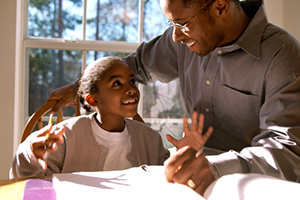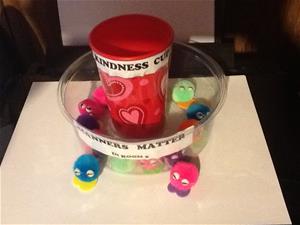 A teacher—particularly one in early education—is teaching more than reading, writing, arithmetic. We know it is simply human nature that we are born selfish, self-centered, and egocentric individuals, and it is a teacher’s job to gently guide students from believing that they are the center of all things and to put others’ interests before their own.
A teacher—particularly one in early education—is teaching more than reading, writing, arithmetic. We know it is simply human nature that we are born selfish, self-centered, and egocentric individuals, and it is a teacher’s job to gently guide students from believing that they are the center of all things and to put others’ interests before their own.
One might think that all a teacher has to do is get the students to say please, thank you, and excuse me, and they will be on their way to becoming model citizens. One would be wrong. It goes far deeper than parroting those simple, yet magical, words. Having a genuine feeling of concern for another’s well-being is at the heart of having manners. To be caring, loving, and kind individuals for society’s benefit as well as their own. One has to care about what other people think and feel. This requires building a caring classroom community.
Putting another’s interests before one’s own, sharing, and waiting one’s turn is extremely hard for most pre-K students. Children need to see a purpose or reason to do these unnatural acts of kindness. This can and must be taught in pre-K, as it lays the foundation for all subsequent grades that follow.
Model good manners
As a pre-K teacher, I model respect for others. On the first day and every day through to the end of the year, I use please, thank you, and excuse me when talking to my students. I tell them when you say these words, you are using good manners and showing others that they are important to you. When I speak to my aide, I always say “yes ma’am” or “no ma’am” because it shows I have respect for her, and I make note of that for my class. I cannot emphasize enough the importance of modeling good manners for students every second of every day. Students imitate what they see, and this is how they make the learning their own.
Manners matter in Room 2
 Because my students and I have discussed the magic words from the first day of school, I can show them how important using good manners really is in our room. Every time I hear polite words or see kind deeds, that student places a pom-pom in a cup—The Kindness Cup. The small, soft balls can be found at any craft store in sizes from very small up to three inches across. We refer to the pom-poms as our “warm fuzzies” because of how good it feels inside to do something nice for a friend. The best part is that when the cup has 10 warm fuzzies, the whole class wins a sticker. The children love being the ones responsible for earning rewards for their friends. I usually read the picture book Warm Fuzzies by Cathie Brown when I introduce the idea, and then we make a warm fuzzy to give to someone we care about.
Because my students and I have discussed the magic words from the first day of school, I can show them how important using good manners really is in our room. Every time I hear polite words or see kind deeds, that student places a pom-pom in a cup—The Kindness Cup. The small, soft balls can be found at any craft store in sizes from very small up to three inches across. We refer to the pom-poms as our “warm fuzzies” because of how good it feels inside to do something nice for a friend. The best part is that when the cup has 10 warm fuzzies, the whole class wins a sticker. The children love being the ones responsible for earning rewards for their friends. I usually read the picture book Warm Fuzzies by Cathie Brown when I introduce the idea, and then we make a warm fuzzy to give to someone we care about.
Maria and Tito
The first week of school, Maria and Tito visit our room. Maria is my look-alike puppet, and I tell the students she is my sister, but she doesn’t know she is a sock. Tito is her best friend and cousin. The puppets interact with funny skits about rules, being nice, and what it takes to be a good friend. Maria often uses catchphrases the children can remember and use themselves, including, “I’m always happy to help,” “It feels so nice to be nice,” and “When a friend is in need, be a friend indeed.” At the end of the minilesson, I encourage the students to ask Maria and Tito questions, which opens up a discussion.
The red paper heart
At the beginning of the year, I cut a large red heart out of construction paper. I tell students it is my heart and that when they are kind to one another and listen to me, my heart is so happy it dances. But when they say unkind things to each other, it hurts my heart and it tears a little (I tear the paper). I go on, explaining that mean words said in anger to a friend crushes my heart—“Words hurt!” (I crumple the paper). Then I try to smooth it out. I ask the students, “Can those words be unsaid? Can this paper ever be the same?” After that, I cut the heart in two and I give each student a colored bandage to help put the heart back together. I tell them you can use words to help your friends feel better, but when you do, say “I’m sorry” and really mean it. I tell students to be careful of the words they use when speaking to friends. I refer to the heart often throughout the year.
Any part of character education must include teaching students self-control. Stating expectations from the first day of school is imperative for my students to be successful. I avoid any frustration on my part, or for my students, when I show them what they need to do for each activity of the day. Immediately before we go to centers or sit on the carpet, I go over what is expected of students. I simply say that this is what successful students do to learn. My aide and I then proceed to model polite talk and good manners in a funny skit in front of the class. Before talking about rules, I always read No, David! and David Goes to School by David Shannon.
Parent communication
Bringing the parents on board to help reinforce what the students learn at school is essential for success. Parents need to see why character education is important. Many parents tell me their children don’t listen to them at home, and the children do whatever they want. Reinforcing my lessons with their child at home will benefit both the parent and child. To stress how important this is to me, I use a section in my weekly newsletter to state what we are working on, with a note to parents: “Please help at home.”
In my pre-K class, I want children to go beyond just saying polite words. I want them to sincerely mean them. Basically, I am teaching each student to be a good person, I hope these strategies help you do the same.
 Mary Van Bibber is a pre-K teacher at Heritage Elementary School in San Antonio, TX.
Mary Van Bibber is a pre-K teacher at Heritage Elementary School in San Antonio, TX.